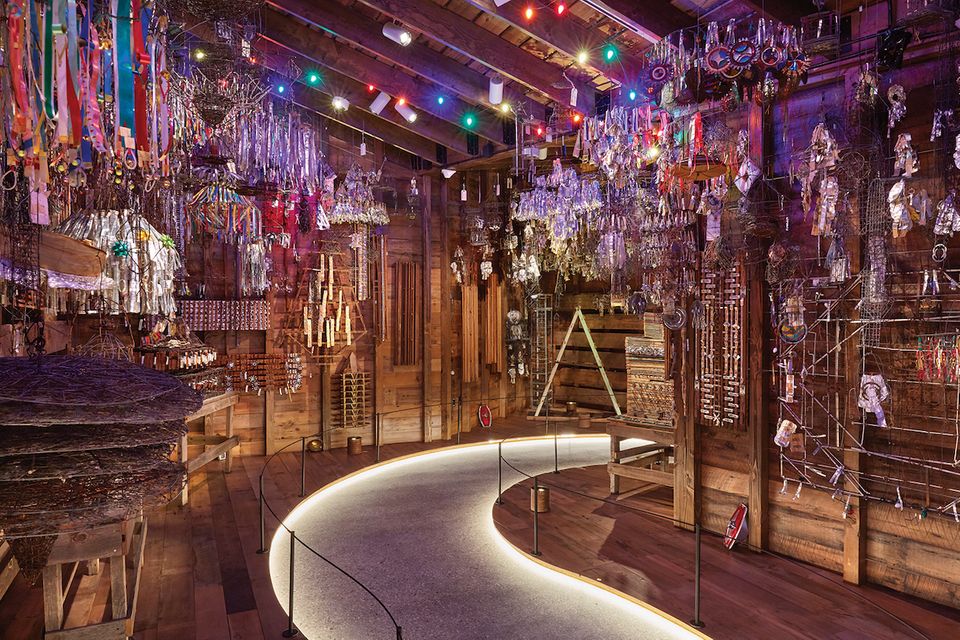
After a ten-month delay resulting from the Covid-19 pandemic, the John Michael Kohler Arts Center in Sheboygan, Wisconsin, is opening the Art Preserve, the world’s first museum dedicated to long-neglected art environments, on 26 June. The 56,000 sq. ft facility will exhibit and store more than 25,000 objects from the Kohler Arts Center’s art environment collection as well as serving as a hub for research on, and displays of, artists’ genre-defying creations.
Similar to site-specific art installations, art environments are meant to be experienced in situ but are generally created without institutional support or context. Associated with folk and outsider art, they are often built out of found material and located within an artist’s home or on the creator’s property. “They are life-specific as opposed to site-specific,” says the museum’s associate curator, Laura Bickford. For example, from 1948 to 1976, the homesteader Fred Smith created some 230 concrete sculptures embellished with salvaged beer bottles and other objects on his farm and around his tavern in Phillips, Wisconsin.
Local residents called Smith’s land the “Concrete Park”, and when the artist died, the Kohler Foundation, an independent body that works with the Kohler Arts Center, acquired the site. “At that time, art environments fell through a cultural gap of care,” says the museum’s associate director, Amy Horst. The foundation “stepped into a void that no other museums were positioned to address”. That effort was led by Ruth DeYoung Kohler II, the long-time director of the Kohler Arts Center and the visionary behind the Art Preserve, who died in 2020 at the age of 79. Ten of Smith’s sculptures are now on view at the Art Preserve.
The foundation’s preservation strategy is not based chiefly on acquisitions, though. Instead, after documenting and evaluating an art environment, it often identifies a steward and, when possible, gifts the site back to the municipality or county in which it is located. “It is our strong preference that the art remain in situ,” says the Kohler Arts Center’s director, Sam Gappmayer.
However, sometimes vulnerable objects are transferred to the museum for safekeeping, and imperilled sites enter the collection in their entirety, as in the case of Loy Bowlin’s Beautiful Holy Jewel Home. Bowlin, a self-described “original rhinestone cowboy”, covered the interior and part of the exterior of his house in McComb, Mississippi with bright paint, construction paper, glitter and rhinestones. In 1998, the Kohler Arts Center acquired four original walls and a portion of the exterior.
Works such as Bowlin’s present a vexing preservation problem; every time it is exhibited or handled, it sheds glitter. “Every single moment is a challenge,” Horst says. “There is the inherent vice of the material”—an archival term for the tendency to deteriorate—and “the question of interpreting work that was never intended to be in a museum and the rupture once the piece is no longer in situ”.
The Art Preserve’s design, by the Denver-based firm Tres Birds, reflects those challenges. The entry is obscured by tall wooden planks that shade the collection while also emulating the feel of happening upon a chance discovery. Once inside, visitors are greeted by a working replica of Smith’s tavern serving local beer. Sitting at the bar affords views of his original work in the gallery.
Throughout the three floors of exhibition space, artists each have their own area consisting of work on display, visible storage and projected images of the original site that invite contemporary artists to respond to it. Design elements within the clusters also recall the landscape where the art previously existed.
Emery Blagdon’s intricate and eerie mobiles made of metal strips and wire originally hung in a shed on his Nebraska property, where he was trying to harness the healing energy of the earth’s electromagnetic fields. The more than 400 components, including perforated aluminium sheets, mechanical odds and ends and vials of minerals, are displayed in a space built from rough-hewn dark planks that mimic the shed. Visitors enter the small enclave to explore an overwhelming array of kinetic objects glittering under Christmas lights.
Being in Sheboygan, a scenic town on the shores of Lake Michigan, “gives us the freedom to be expansive”, Horst says. “You can take more risks and even fail sometimes.” An hour’s drive from Milwaukee airport, it is now home to two large arts facilities, and the Kohler Arts Center staff hope it will become an art destination. “Marfa is aspirational to us,” Gappmayer acknowledges, referring to the Texas art mecca masterminded by the Minimalist sculptor Donald Judd, “though Minimalism is in stark contrast to the flamboyance of these artists”.